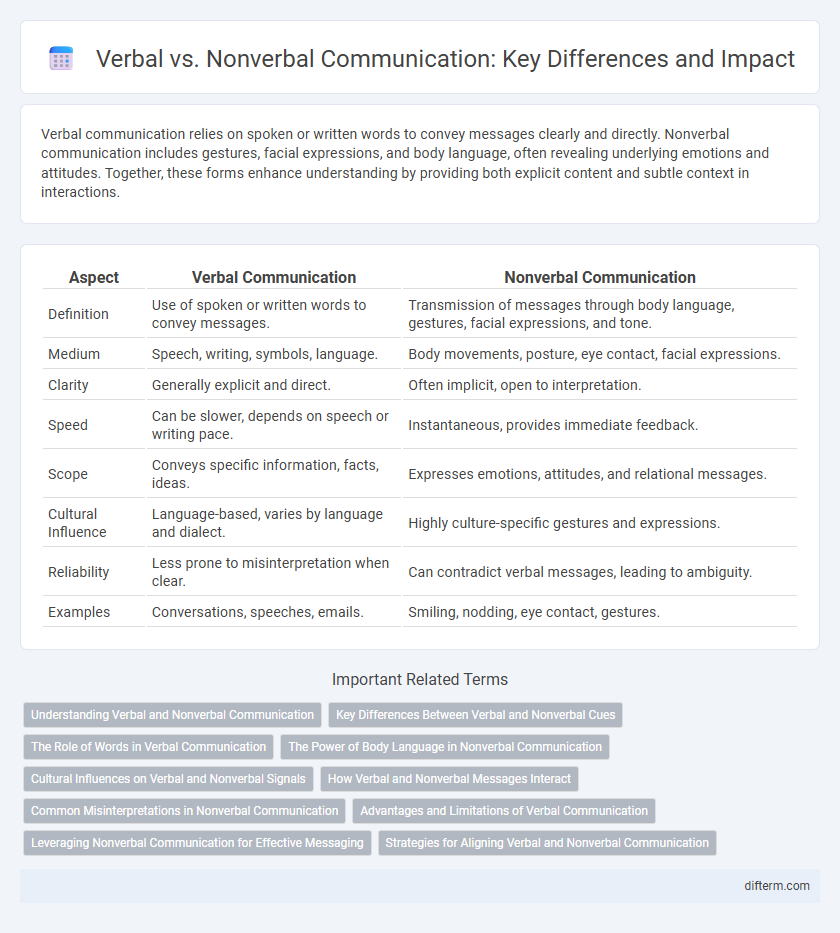Verbal communication relies on spoken or written words to convey messages clearly and directly. Nonverbal communication includes gestures, facial expressions, and body language, often revealing underlying emotions and attitudes. Together, these forms enhance understanding by providing both explicit content and subtle context in interactions.
Table of Comparison
| Aspect | Verbal Communication | Nonverbal Communication |
|---|---|---|
| Definition | Use of spoken or written words to convey messages. | Transmission of messages through body language, gestures, facial expressions, and tone. |
| Medium | Speech, writing, symbols, language. | Body movements, posture, eye contact, facial expressions. |
| Clarity | Generally explicit and direct. | Often implicit, open to interpretation. |
| Speed | Can be slower, depends on speech or writing pace. | Instantaneous, provides immediate feedback. |
| Scope | Conveys specific information, facts, ideas. | Expresses emotions, attitudes, and relational messages. |
| Cultural Influence | Language-based, varies by language and dialect. | Highly culture-specific gestures and expressions. |
| Reliability | Less prone to misinterpretation when clear. | Can contradict verbal messages, leading to ambiguity. |
| Examples | Conversations, speeches, emails. | Smiling, nodding, eye contact, gestures. |
Understanding Verbal and Nonverbal Communication
Verbal communication conveys explicit meaning through spoken or written words, making clarity and vocabulary essential for effective understanding. Nonverbal communication, such as body language, facial expressions, and tone of voice, provides critical context that influences message interpretation and emotional impact. Decoding both verbal and nonverbal cues enhances overall comprehension in interactions, reducing misunderstandings and improving relational dynamics.
Key Differences Between Verbal and Nonverbal Cues
Verbal communication relies on spoken or written words to convey messages, emphasizing clarity and explicitness through language structure and vocabulary. Nonverbal communication encompasses body language, facial expressions, gestures, and tone of voice, which often reveal emotions and intentions beyond spoken words. The key differences between verbal and nonverbal cues lie in their modes of expression, with verbal cues providing direct information and nonverbal cues offering indirect, contextual, and often subconscious signals.
The Role of Words in Verbal Communication
Words serve as the fundamental units of verbal communication, enabling precise expression of ideas, emotions, and intentions through language. They facilitate clarity and structure in conversations, allowing individuals to convey complex messages effectively. The choice of vocabulary, tone, and syntax in words significantly influences the interpretation and impact of verbal exchanges.
The Power of Body Language in Nonverbal Communication
Body language accounts for over 55% of the impact in face-to-face communication, making it a critical component of nonverbal interaction. Facial expressions, gestures, and posture convey emotions and intentions more authentically than words, often shaping perceptions subconsciously. Mastery of body language enhances persuasive communication, trust-building, and emotional intelligence in both personal and professional contexts.
Cultural Influences on Verbal and Nonverbal Signals
Cultural influences significantly shape both verbal and nonverbal communication, with language, tone, and idiomatic expressions varying widely across cultures, affecting interpretation and meaning. Nonverbal cues such as gestures, eye contact, and personal space also differ, where, for example, direct eye contact may be respectful in Western cultures but considered rude in some Asian societies. Understanding these cultural nuances is essential for effective cross-cultural communication and minimizing misunderstandings.
How Verbal and Nonverbal Messages Interact
Verbal and nonverbal messages interact to create a comprehensive communication experience where spoken words convey explicit content while body language, facial expressions, and tone provide emotional and contextual cues. Nonverbal signals often reinforce or contradict verbal messages, influencing the receiver's interpretation and ensuring clarity or highlighting discrepancies. Successful communication depends on the alignment of verbal expression and nonverbal behavior to accurately transmit meaning and intent.
Common Misinterpretations in Nonverbal Communication
Nonverbal communication often leads to common misinterpretations, such as mistaking a lack of eye contact for disinterest or dishonesty, when it may indicate cultural norms or social anxiety. Gesture meanings vary widely across cultures, causing gestures like the thumbs-up or nodding to be misread. Facial expressions and body language can be ambiguous, leading to incorrect assumptions about emotions or intentions without verbal clarification.
Advantages and Limitations of Verbal Communication
Verbal communication allows for precise expression of ideas and complex information, facilitating clarity and immediate feedback through spoken or written language. It supports detailed explanations and emotional nuances using tone, pitch, and volume, enhancing interpersonal connections. However, verbal communication relies heavily on language proficiency and can be misinterpreted without nonverbal cues, limiting its effectiveness in cross-cultural or noisy environments.
Leveraging Nonverbal Communication for Effective Messaging
Nonverbal communication, including facial expressions, gestures, and body language, significantly enhances message clarity and emotional impact. Leveraging these cues increases engagement and helps convey authenticity, often surpassing the influence of verbal communication alone. Mastering nonverbal signals improves interpersonal connections and reduces misunderstandings in professional and personal interactions.
Strategies for Aligning Verbal and Nonverbal Communication
Aligning verbal and nonverbal communication enhances message clarity and builds trust by ensuring consistency between spoken words and body language. Strategies include maintaining eye contact, using gestures that reinforce verbal points, and matching facial expressions to the emotional tone of the message. Monitoring and adjusting these cues in real-time improves engagement and reduces misunderstandings in interpersonal interactions.
verbal vs nonverbal Infographic

 difterm.com
difterm.com